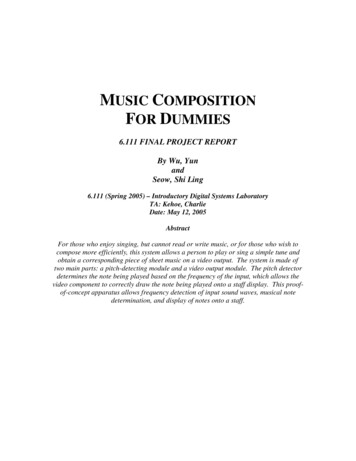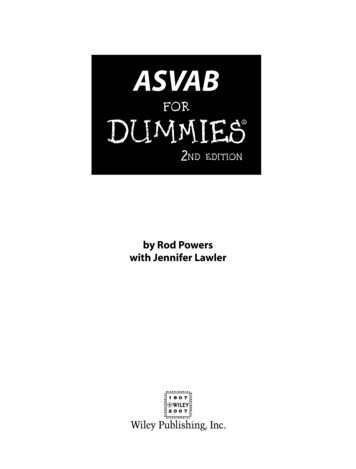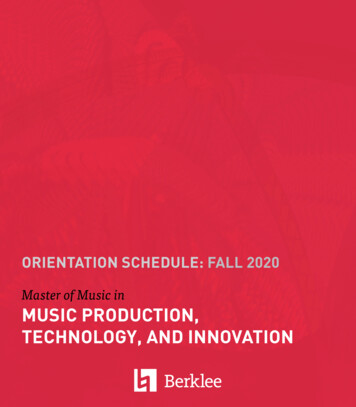
Transcription
MUSIC COMPOSITIONFOR DUMMIES6.111 FINAL PROJECT REPORTBy Wu, YunandSeow, Shi Ling6.111 (Spring 2005) – Introductory Digital Systems LaboratoryTA: Kehoe, CharlieDate: May 12, 2005AbstractFor those who enjoy singing, but cannot read or write music, or for those who wish tocompose more efficiently, this system allows a person to play or sing a simple tune andobtain a corresponding piece of sheet music on a video output. The system is made oftwo main parts: a pitch-detecting module and a video output module. The pitch detectordetermines the note being played based on the frequency of the input, which allows thevideo component to correctly draw the note being played onto a staff display. This proofof-concept apparatus allows frequency detection of input sound waves, musical notedetermination, and display of notes onto a staff.
1. Design OverviewOur project “Music Composition for Dummies” allows amateurs to create a“masterpiece” by simply singing into a microphone. The microphone is inputted into asystem that has two main parts: a pitch detector and a video display. The pitch detectorretrieves audio data bits from an audio codec, performs a 1024-point Fast FourierTransform, and determines the frequency and the note value of the input sound. Thisnote value is fed into the video display module, which displays the note onto a staff onthe video screen. Figure 1 shows the block diagram of the overall system.Input audiodata fromcodecPitchDetectorNotevaluesVideoDisplayNotes onstaffFigure 1: Block diagram of overall systemThe project not only demonstrates how to extract audio data, how to use FFT forfrequency detection, and how to implement a video display, but also incorporates manyimportant aspects of large-scale digital systems design and integration. The entire systemrequires utilizing existing Xilinx audio, video, and labkit modules as well as developingfinite state machines to correctly time and send control signals to the existing modules.The project is interesting because besides coding, it also allows us to build analogcircuitry, use external peripherals, and employ our creativity while developing a productthat is very practical for musicians and dummies alike. Our project demonstrates a proofof-concept that the frequency of sound waves can be detected and displayed as musicalnotes. On a more robust level, our device could potentially allow anyone to easilycompose music by singing, as well as play an existing song on a CD and obtain thecorresponding score.2. Design Description2.1 Pitch Detector (Yun Wu)The main purpose of the pitch detector is to transform audio data bits from the codec intoa corresponding note value by performing a Fast Fourier Transform of the input data anddetermining the peak of the frequency domain audio spectrum. Figure 2 shows a blockdiagram of the pitch detector.6.111: Music Composition for Dummies1
Figure 2: Block diagram of pitch detectorThe external input signals of the pitch detector include a reset from the labkit module, aswell as the bit-clock from the ac97 module that interfaces with the audio codec. Inaddition, the two crucial input signals are the “ready” signal and the 16-bit“right in data”. “Ready” signals that audio data is valid, and the most significant 16 of20 bits in the audio data “right in data” are stored into the RAM dp whenever theRAM controller detects a rising or falling edge in the “ready” signal. The RAM dpstores 2048 lines of data, and is addressed with 11 bits. In general, the xfft1024 modulewill process 1024 lines of data, so it will index through half of the data in the RAM dp,while the newly inputted audio data is stored in the other half. Since the rate of FFTcomputation is much higher than the rate of input data storage, the xfft1024 module mustwait until a rising or falling edge transition of the most significant bit of the waddressindicating that 1024 lines of data have been stored, before it can begin computation again.The following Figure 3 shows a state transition diagram of the FFT controller modulethat sends control signals to the xfft1024 module.6.111: Music Composition for Dummies2
“Ram waddr msb” equal to“prev ram waddr msb”StartIDLE“Ram waddr msb” not equal to“prev ram waddr ure 3: State Transition Diagram of FFT controllerUpon a global reset signal, the FFT controller enters into the IDLE state. On the nextclock cycle, it enters the setDefaults state where parameters are sent to the Xilinxxfft1024 module telling it the size of the transform to be computed (nfft), a scalingschedule (scale sch), whether to perform a forward or inverse transform (fwd inv), etc.These parameters are registered into the xfft1024 module by the FFT controller’s pulsingof the respective write enable signals. Next, the FFT enters the pulseStart state, where itcommands the xfft1024 to begin computing the transform. The FFT controller waits forthe RAM controller to finish writing 1024 data lines to the RAM dp in thewaitforRAMcontroller state before returning to the pulseStart state, and repeating thetransform operation.After the xfft1024 module computes the 1024-point transform of the input data, therespective imaginary and real frequency output points (xk im) and (xk re) that areindexed by xk index are sent to a multiply/accumulate unit. In the multiply accumulateunit, the squared magnitude of each point in the transform is computed. Next,xk mag sqd for each point along with the corresponding index that ranges from 0 to1023 (rd addr) is sent to the comparator unit. The comparator determines the peak of thefrequency spectrum, and sends the index of the peak to a lookup table called notesROM.The lookup table matches the index of the peak (max index) to a corresponding 5-bitnote value representing the note to be drawn. In this project, the output notes are limitedto one octave between middle C and high G on the treble clef, and all other notefrequencies are considered out of range and are displayed with either a quarter rest or anempty bar respectively depending on whether the out of range note is too low or too high.2.2 Video Display (Shi Ling Seow)The video component is implemented on a VGA display with a resolution of 1024 x 768and a screen refresh rate of 61.74 Hz. The timing values are listed in Table 1 below. Thiscomponent consists of three modules as shown in Figure 4: the BRAIN module, WRITE1module and the VIDEO DAC. The CORE Generator tool is used to generate a built-inRAM that can store 786432 one-bit data and a ROM that can store 45056 one-bit data.The display is divided into 384 32 x 64 blocks where each block is an image of a singlenote as shown in Figure 6.6.111: Music Composition for Dummies3
Table 1: Timing values for video MHz)64.8Horizontal (in Pixels)Vertical (in 285BRAINpixel clockdone videostart videonote now 5WRITEB8G8R827mhz clockreset2 color selvga outVIDEO DACFigure 4: Block diagram of the video componentBRAIN moduleSince the output rate of the pitch detector is only approximately 3 Hz while the video hasa much higher screen refresh rate (61.74 Hz), a separate module is needed to regulate thedata flow between these two components to prevent the video from displaying the samenote consecutively and filling up the screen too fast. The BRAIN module runs on a 64.8MHz clock and takes in a reset signal, a 5-bit data (note in) which indicates the note thathas been detected by the pitch detection component, and a done signal from the WRITEmodule. Then BRAIN outputs a 5-bit data (note now) which selects the note to bedisplayed and a start signal to indicate that the WRITE module should display the newnote on the screen. BRAIN has four states as shown in Figure 5. When the reset button ispressed, the state will return to IDLE and the start signal is reset to zero. During theIDLE and RESTART state, the data that is received from the pitch detector, note in, isstored in a variable called note temp. Note now is set to be the same as note temp for allthe states. The DECIDE state will loop back to itself until the pitch detector outputs anew note that is different from the previous one. Then the start signal is set high and thestate transitions to WAIT where start is kept high until a done signal is received from theWRITE module. Then the state transitions back to RESTART and the steps are repeated.6.111: Music Composition for Dummies4
RESTARTresetIDLEdone 1start 0start 0note temp note innote now note tempstart 0note temp note innote now note tempstart 0DECIDEnote now note tempnote now note tempWAITnote temp note instart 1start 1Figure 5: State transition diagram of the BRAIN moduleWRITE moduleThe WRITE module consists of three main sections: DCM module, internal signalsgenerator, and a finite state machine. The DCM module generates a 64.8 MHz pixel clockusing a 27 MHz clock. The internal signal generator takes in a 64.8 MHz clock andgenerates a hsync and a vsync signal for the video display timing. The finite state machineconsists of a read section and a write section. There is also a section which initializes theRAM with data from the ROM to display an empty bar when the reset signal is pressed.This method of initializing the RAM is used because initializing from a .coe file wouldtake too long to simulate due to the size of the RAM. The RAM is used to keep a one-bitdata for all the pixels on the display, with a zero to represent the background and a one torepresent the foreground. The ROM stores 22 32 x 64 bitmaps of the displayed notes,each bit representing a pixel on the screen as shown in Figure 6.This design is simple and does not require too many pointers and counters as the data forthe video display is obtained directly from the RAM. No doubt this would require theRAM to be extremely large to be able to store all the pixels but since our display onlyshows two colors, the RAM only has to store one-bit data for each pixel. The write countvariable keeps track of the next writing point on the RAM and the read count variablekeeps track of the next reading point on the RAM. Pointer points to the next block of datathat needs to be written. Rom count is used to point to the ROM address where the datato be written into RAM in obtained from.When the reset signal is high, the state transitions to IDLE. Then the SET state loopsback to itself until two cycles before the blanking period begins. The ROM address isfirst set to point to the block where the image of an empty bar is stored before the state istransitioned to SETRAM where the ROM address is incremented and write count is setto the pointer value. Then both the ROM address and the RAM address are incrementedand the write enable signal is set to high in state SETROM. The WRITE state then loopsback to itself and continues to increment both the ROM and the RAM addresses until it6.111: Music Composition for Dummies5
reaches the end of the RAM buffer. Now the write enable signal is set back to low andwrite count is reset back to address zero. The WAIT state loops until one cycle beforethe blanking period is over. Then it transitions to state READ the RAM address isincremented and the data from RAM is read at every pixel clock cycle until the one cyclebefore the horizontal blank period. READ then transitions to READWAIT which loopsuntil one cycle before the end of the horizontal blank period. Then the state transitionsback to the READ state to continue displaying on the screen. This back and forthtransitioning between READ and READWAIT state continues until the end of the RAMaddress. If the start signal from the BRAIN module is low, READWAIT transitions toWAIT. But if the start signal is high and if the pointer is pointing at the first block rightafter the edge of the screen, (see Figure 6) READWAIT transitions to TREBLERAMwhere the ROM address is incremented and write count is set to the pointer value. TheROM at this point is pointing to the bitmap of a treble clef so that a new treble clef wouldbe written at the beginning of the bar. Then both the ROM address and the RAM addressare incremented and the write enable signal is set to high in state TREBLEROM. TheTREBLEWRITE state then loops back to itself and continues to increment both the ROMand the RAM addresses until a block of data has been written into RAM. Now the writeenable signal is set back to low and write count is set to pointer which is pointing to thenext block where the next note will be written. Then the state transitions to WRITERAM,WRITEROM, and WRITING where all the procedures in TREBLERAM,TREBLEROM, and TREBLEWRITE are repeated but with the ROM address set to thenote now value that was outputted by the BRAIN module. If the pointer is not pointing atthe first block right after the edge of the screen and the start signal is high, READWAITtransitions to WRITERAM instead and skips the step of writing the treble clef. At the endof the WRITING state, the done signal is set to high and the state transitions to WAIT.Figure 7 shows the state transition diagram for the WRITE module.64 pixelsEdge of screen1024 pixels(12 blocks)VGA DISPLAY32 pixels768 pixels(32 blocks)Figure 6: The VGA display is divided into 32 x 12 blocks. Each block contains a bitmapof size 32 x 64 pixels which is stored in the RAM.6.111: Music Composition for Dummies6
INITIALIZE RAM2 cyclesbefore vblankwrite count pointerrom count rom count 21 * 2048resetSETROMSETRAMSETwidth count rom count write count IDLEREADS1 cyclebefore hblankread count READWAITnot end of screenend of screenrom count 20 * 2048READ1 cyclebefore end ofhblankwrite count rom count WRITErom count 0WAITend of ram1 cyclebefore readcycle startsend of blockstart 0write count rom count WRITINGTREBLERAMwrite count pointerrom count TREBLERAMwidth count rom count write count WRITERAMwrite count pointerrom count write count rom count TREBLEWRITEWRITEROMend of blockwidth count rom count write count WRITESFigure 7: State transition diagram of the WRITE moduleFinally, each bit is assigned a 24-bit value to represent the vga out blue, vga out red,vga out green that has 8-bit each to be outputted to the video DAC and displayed.Color sel is a synchronized 2-bit input that can be controlled by two switches to changesthe combination of the foreground and background color.3. Design Methodology and Design Trade Offs3.1 Pitch Detector (Yun Wu)We explored several methods of pitch detection including time domain methods such ascounting zero crossings and using autocorrelation, but eventually decided on using theFast Fourier Transform to produce a frequency spectrum of the sound wave, and findingthe peak. Although the mathematics behind the FFT seemed extremely complicated atfirst, we were able bypass most of the details by implementing our project using anexisting Xilinx Corgen module.6.111: Music Composition for Dummies7
The sampling rate turned out to be a crucial decision of the pitch detecting module.Although the input audio data entered at a frequency of 48kHz, I decided to decrease theinput RAM storage rate by a factor of 16 to 3kHz, so that the frequency spectrumproduced by the FFT module would have a higher resolution. With a sampling rate of3kHz, the1024 point transform allowed each bin to have roughly a 3-Hz resolution.Since the frequencies corresponding to the notes on the treble clef display ranged from261 Hz (Middle C) to 784 Hz (High G), the sampling rate of 3kHz allowedapproximately 20% of the points in the transform (between point 86 and point 278) to bematched to notes. If the frequency were determined to be out of range, meaning that themaximum point was below point 86 or above point 278, then the pitch detector wouldinstruct the video display to output a rest or an empty bar respectively.The relatively slow sampling rate allowed for higher probability of hitting a note valuewhen singing, but compromised the number of notes that could be captured. Wediscovered that when an input midi file contained notes that changed too quickly, thepitch detector could only produce one of every few notes.3.2 Video Display (Shi Ling Seow)There are various ways to implement a video component and each has its own strengthsand weaknesses. The main objective of my design is to minimize the number of pointersused to reduce complexity. The design is relatively simple and straightforward as it doesnot require too many pointers and counters since the data for the video display is obtaineddirectly from the RAM. No doubt this design would require a large RAM to store data forall the pixels but since our display only shows two colors, the RAM only has to store aone-bit data for each pixel.I also chose to not initialize the RAM with a .coe file because simulation would take toolong due to the size of the RAM. Therefore, I wrote a simple three state FSM to initializethe RAM whenever the system is reset. The video display will miss the first read cyclebut since the refresh rate is so high, the human eye will not be able to detect this latency.Since the output rate of the pitch detector is only approximately 3 Hz while the video hasa much higher screen refresh rate (61.74 Hz), a separate module is needed to regulate thedata flow between these two components to prevent the video from displaying the samenote consecutively and filling up the screen too fast.All the reads and writes are implemented on a single FSM instead of using a major andminor FSM. I chose to do it this way because the video already has very complicatedtiming constraints and splitting the controls into several modules would just add moretiming and synchronization issues to the video component.4. Testing and Debugging4.1 Pitch Detector (Yun Wu)Debugging the pitch detector was extremely cumbersome mostly because of the xfft1024module. As it turned out, there was not an easy way to simulate the Corgen FFT block,6.111: Music Composition for Dummies8
so most of the debugging was done by sending signals out to a logic analyzer.Everything after the FFT module as well as the fft controller and ram controller weresimulated using Max plusII and ModelSim. The following Figures 8, 9, and 10 show theram controller, fft controller, and everything after the FFT module in simulation.Figure 8: Ram controller in simulationFigure 9: FFT controller in simulationFigure 10: Everything after the FFT module in simulation.6.111: Music Composition for Dummies9
4.2 Video Display (Shi Ling Seow)I coded and tested my design one layer at a time as the video component has verycomplicated timing issues. By doing so, I could detect errors easily and mistakes can bedetected earlier before the code becomes too complex. First, I tried displaying data from aRAM by just reading directly from RAM without any write procedures. The next stepwas harder as I tried to write from ROM to RAM and then read from the RAM. At thispoint I wasn’t writing in blocks and was merely writing sequentially to familiarize myselfwith the READ and WRITE timings. Once I have managed to do that, I went on to writein blocks. This part took up the bulk of my time as it was difficult to keep track of somany pointers in my code. But after that was done, polishing the details was relativelysimple.For the purpose of testing and debugging, besides displaying the data on the video screen,I also simulated all my codes using Max PlusII for simple codes that did not require theuse of RAM and ROM such as the BRAIN module and used ModelSim for simulatingother modules as it ModelSim is linked directly from Xillinx. The DCM module couldnot be simulated in ModelSim so a different clock was generated for the purpose ofsimulation. Also, because the timing specification of the video is very long, certaintiming constants were reduced for faster simulation. Figure 11 shows the simulation forthe write timing and Figure 12 shows the simulation for the read timing. Figure 13 showsthe simulation for the BRAIN .start writeFigure 11: Simulation of write timing for video. The ROM address is provided one cyclebefore write enable is set high so that the data from that ROM would be available on thenext cycle to be written into RAM address zero.6.111: Music Composition for Dummies10
beginning of read cycleFigure 12: Simulation of read timing for video. The first RAM address to be read isprovided one cycle before the beginning of the read cycle so that the data from RAMwould be available when the read cycle begins.start signal goes high when previousnote is different from the current noteFigure 13: Simulation of the BRAIN module5. ConclusionOur system demonstrates that input audio data can be processed by an FFT module, andthe corresponding note can be determined by detecting the peak of the input frequencyspectrum. The notes can be directly fed into the video display module, which outputs thenotes one at a time onto a staff. The system is reliable for determining and displaying thefrequency of preset sinusoidal signals by a signal generator, as well as determining thecorresponding note values to be displayed. Our system is mainly limited by its inputsampling rate of 3kHz, as we sometimes missed a few notes when the music changedquickly or when the notes included harmonics out of our range. Future additions couldinclude a larger note range, as well as detecting the duration of notes, displaying differenttypes of notes depending on duration, scrolling screen and filtering input from themicrophone so that pitch detection can be performed from a note sung into themicrophone.6.111: Music Composition for Dummies11
AcknowledgementsThe authors would like to express their sincere gratitude and appreciation to severalpeople, without whom this project would not be possible. First we would like to thankNathan Ickes for the wonderful new lab kit and all of the technical expertise he provided.Next, we would like to thank Keith Kowal for his video expertise, as well as the rest ofthe friendly lab support staff for lending us microphones, speakers, and variousperipherals. Finally, we would like to thank our TAs: Charlie Kehoe, Jenny Lee, andChris Forker for countless hours of patience, support, encouragement and help, and Prof.Anantha Chandrakasan for his kindness, time and effort in making 6.111 a trulymemorable class.References[1] “Fast Fourier Transform v3.0” Product Specification. Xilinx Logicare. 5/21/2004.[2] Ickes, Nathan “Audio Input and Output” shtml [3] Ickes, Nathan. “Methods for Programming the Labkit” uration.shtml [4] “LM4550 AC ’97 Rev 2.1 Multi-Channel Audio Codec with Stereo HeadphoneAmplifier, Sample Rate Conversion and National 3D Sound” National Semiconductor.8/2003.[5] Chuan, Ching-Hua and Zhu, Kevin “Guitar Scores Interpretation: TransformingAudio into Guitar Tab Scores” http://www-scf.usc.edu/ chinghuc/ise599.html 6.111: Music Composition for Dummies12
The project is interesting because besides coding, it also allows us to build analog circuitry, use external peripherals, and employ our creativity while developing a product that is very practical for musicians and dummies alike. . 6.111: Music Composition for Dummies 5 Figure 5: State transition diagram of the BRAIN module WRITE module










